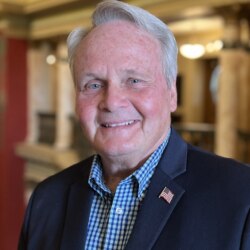Indians, Property Rights, and Ayn Rand
In 1876, when rejecting the demand to move his people to a reservation, Chief Joseph said, “I claim a right to live on my land and accord you the privilege to return to yours.” To me, that sounds like a man who understands private property.
At Lincoln Hall in Washington, D.C. on January 14, 1879, a remarkable Native American delivered a speech in which he implored,
Let me be a free man, free to travel, free to stop, free to work, free to trade where I choose, free to choose my own teachers, free to follow the religion of my fathers, free to talk, think and act for myself—and I will obey every law or submit to the penalty.
His name? Hin-mah-too-yah-latkekht (Thunder Rolling Down the Mountain), better known to us today as Chief Joseph of the Nez Perce. Chased by 2,000 men of the U.S. army cavalry in the summer and fall of 1877, he led 750 of his people 1,170 miles from eastern Oregon to Idaho, then Wyoming and Montana before surrendering in the Bear Paw Mountains near the Canadian border. There, he declared,
“I am tired. My heart is sick and sad. From where the sun now stands, I will fight no more forever.”
The primary issue that started the five-month “Nez Perce War” was the federal government’s breach of a treaty and its desire to forcibly confine the Nez Perce to a reservation of the government’s choosing. Chief Joseph died in 1904. Neither he nor his people were allowed to return to their ancestral lands in northeastern Oregon. Some 3,500 Nez Perce live today on their reservation, which is entirely within Idaho.
Today, depending on whose numbers you trust, Native Americans comprise between 4 and 6.3 percent of the Montana population, compared to less than two percent nationwide. The largest tribe in the country is the Cherokee, at about 1.1 million, while the largest in the Treasure State is the Blackfeet, at 30,000.
A festering question concerning Native Americans is that of property rights, the extent to which the various tribes and their individual members possessed them—both when white settlers first arrived and even today.
Philosopher Ayn Rand (author of Atlas Shrugged) got many things right, but she also got two very big things wrong. One was that life is the result not of intelligent design but of pure chance, an observation that science is increasingly debunking (see Science Is Affirming Creation, Not Accident).
Her other big error was that driving Native Americans such as Chief Joseph and his Nez Perce off their lands was no big deal because they were unsettled, wandering nomads who never believed in private property anyway. Perhaps she watched one too many cowboys-and-Indians movies.
Two excellent sources on this subject are Ryan McMaken’s article, Native Americans and the Concept of Private Property and a book by Tom Flanagan, Christopher Alcantara and André Le Dressay titled Beyond the Indian Act: Restoring Aboriginal Property Rights.
“Virtually all Indian tribes recognized the validity of personal property,” writes McMaken. “Individual tribe members were not expected to ‘share’ their horses, weapons, dwellings, and slaves among all other members of the tribe.” Moreover, many tribes (such as the Pueblo in New Mexico) farmed the land they lived on and did not wander as nomads do.
Manny Jules is a member of the Secwépemc tribe from British Columbia. In his Foreword to Beyond the Indian Act, he writes,
We had individual property rights. Our clothes and shoes were not made to fit everyone. Our winter homes belonged to certain families. According to our written history, my community had individual property rights dating back to the early 1800s to specify where our potato crops were.
Native American tribes often held land in common rather than as plots owned by individual members. That didn’t make them full-blown “collectivists” or communists, as Rand implied, because the arrangement was typically voluntary and delegated. It often included allowing their chiefs to sell deeds to the land on behalf of them all and then dividing the proceeds among the individuals of the tribe.
Critics of traditional Native American culture such as Ayn Rand suggest that the Indians had no right to land they didn’t physically improve or enclose. Yet even white settlers knew where “Indian land” was precisely because the Indians used it, farmed it, or protected it. And by excluding other peoples from hunting or fishing on their property, they were indeed improving it (or at least maintaining it) by preventing excessive hunting or over-fishing.
Property rights are crucial to good stewardship of resources. When something is owned by no one—neither specific individuals nor a group acting on behalf of its members—then the incentives are to use it and abuse it. Under such non-ownership circumstances, it’s in nobody’s direct interest to cultivate and preserve it.
The Nez Perce viewed Oregon’s Wallowa Valley, where they had lived for centuries, as their property, their home. They became nomads only for a few months, and only because armed men on horseback were in hot pursuit.
In 1876, when rejecting the demand to move his people to a reservation, Chief Joseph said, “I claim a right to live on my land and accord you the privilege to return to yours.” To me, that sounds like a man who understands private property.
*****
Lawrence W. Reed writes a monthly column for the Frontier Institute in Helena, on whose board he serves. He is president emeritus of the Foundation for Economic Education and blogs at www.lawrencewreed.com.
